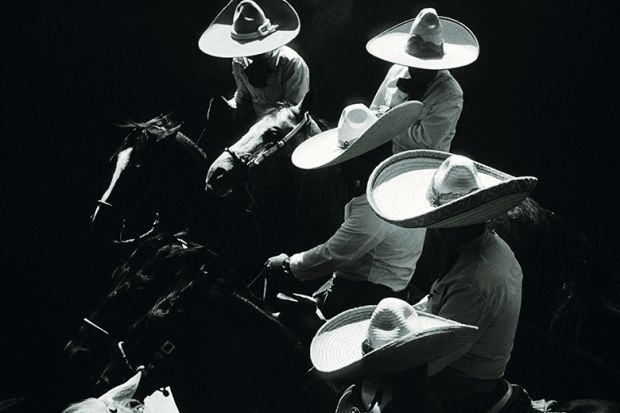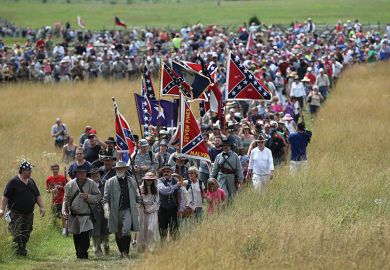Mexican-American cultural theorist and poet Gloria Anzaldúa explored what she called “life in the borderlands” – the complex mix of race, gender and sexuality trapped on the margins of white patriarchy. Capturing a sense of defiance in the face of racial and cultural imperialism, she observed: “When other races have given up their tongue, we’ve kept ours. We know what it is to live under the hammer blow of the dominant norteamericano culture.” There are many paths of defiance, from radical challenge to subtle assertion of selfhood and cultural pride.
Laura Barraclough’s Charros focuses on the latter: the way in which the Mexican-American landowning middle class deployed the image of the charro – the “Mexican cowboy” of her subtitle – to subtly assert their dignity. In doing so, charros distinguished themselves from the stereotype of the lazy immigrant and ingratiated themselves with middle-class whites sufficiently to achieve political and economic gains.
After the Treaty of Guadalupe Hidalgo in 1848, many Mexican-Americans went from being landed gentry in Spanish-colonised Mexico to a landless minority in a white-majority United States. The American cowboy became “the symbol of working-class, white, rugged manhood”, writes Barraclough, divinely ordained and guiding Americans towards western expansion. In contrast, for Mexican-Americans, the charro became a distinctly more majestic symbol of nationalism whose elegant ceremonial dress, trajes de charro, signalled what the author describes as “dignity, skill, and cultural pride”. The skills on display in the traditional charrería arguably surpass any seen at a Western rodeo in terms of physicality and performance.
This compelling cultural history complicates stereotypes of race and class. In the 1940s, for example, the Mexican-American sheriff of Los Angeles, Eugene Biscailuz, regularly donned the charro regalia, which, suggests Barraclough, “allowed him to claim legitimacy” among the city’s (white) elite and simultaneously established him as a cultural token for the immigrant population. Other Mexican-Americans in pursuit of upward mobility followed his lead by reclaiming charro culture as a symbol of pride and a counterpoint to zoot-suited working-class Mexican-Americans.
Barraclough expertly highlights the complexities of race and class as she explains that Biscailuz used the charro identity as cover while he repatriated 2 million poor Mexicans and drove a class wedge between dignified charros and what he called the “wolf packs” of ethnic Mexican youth. With his retirement, the Los Angeles Police Department embraced white, professionalised, modern policing and unleashed these race and class tensions.
When San Antonio, Texas faced significant post-war economic decline, reports Barraclough, the Anglo business elite found a “special kinship” with “middle-class charro-businessmen who shared their ideologies of profit and progress”. City officials capitalised on charro culture to expand the tourist industry, placing mariachi bands along the new River Walk of restaurants and bars – and charro-businessmen rose quickly up the economic ladder. Just as the Professional Rodeo Association governs the sport of rodeo, regional and national charro associations govern the charrería and have established strategic political alliances to lobby legislators, assert their centrality to American history and subtly challenge the whitewashing of the American cowboy.
Anzaldúa did not live to witness today’s horrific scenes of those trapped in the borderlands. But alongside Barraclough’s compelling account of pride and strategic politics in Charros, her words aptly capture Mexican-American defiance against those who continue to assert white superiority: “stubborn, persevering, impenetrable as stone, yet possessing a malleability that renders us unbreakable, we, the mestizos and mestizas, will remain.”
Angelia R. Wilson is professor of politics at the University of Manchester.
Charros: How Mexican Cowboys Are Remapping Race and American Identity
By Laura R. Barraclough
University of California Press, 304pp, £66.00 and £24.00
ISBN 9780520289116 and 9780520289123
Published 16 April 2019
Register to continue
Why register?
- Registration is free and only takes a moment
- Once registered, you can read 3 articles a month
- Sign up for our newsletter
Subscribe
Or subscribe for unlimited access to:
- Unlimited access to news, views, insights & reviews
- Digital editions
- Digital access to THE’s university and college rankings analysis
Already registered or a current subscriber? Login









